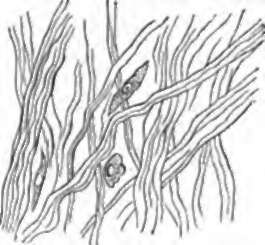10. White Fibrous Tissue
Description
This section is from the book "Animal Physiology: The Structure And Functions Of The Human Body", by John Cleland. Also available from Amazon: Animal Physiology, the Structure and Functions of the Human Body.
10. White Fibrous Tissue
The term connective tissue is a very general one, and the varieties to which we have already referred are the homogeneous and areolar; but there are others which are more markedly fibrous, and constitute the group of white fibrous tissues, namely, fascia, aponeurosis, tendon, and ligament.
Fascia is the name given to strong, felted arrangements of white fibrous tissue spread out in sheets. An aponeurosis is a sheet of white fibrous tissue arranged in parallel fasciculi, or in two or more sets of decussating fasciculi, and having in consequence a shining appearance. Tendon is white fibrous tissue used for the attachment of muscles, and may either be arranged in the form of aponeurosis or in solid bands; it has a satin-like lustre of considerable brilliancy. When tendons rupture during life, they snap straight across. Ligament is white fibrous tissue used for binding bones together; it is not so lustrous as tendon; and when it gives way, which is very seldom, it does not snap but tears. In all these fasciculated forms of connective tissue, the corpuscles are elongated, and lie in the direction of the fibres. In tendon they are flattened, and have been seen in specimens from young animals to lie in sheets between bundles of the fibrous substance. Tendon and ligament are quite inextensible, and all white fibrous tissue, even when by injury to its texture it is gradually stretched, is destitute of resiliency.

Fig. 5. Aponeurosis, human.
Continue to:
